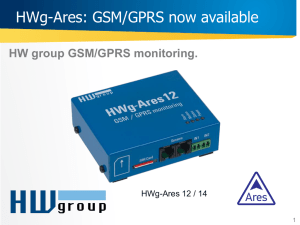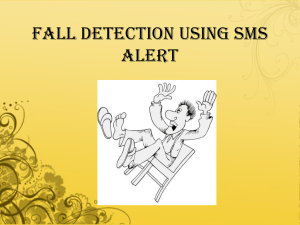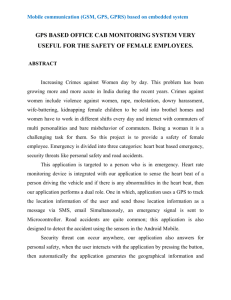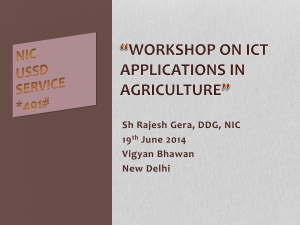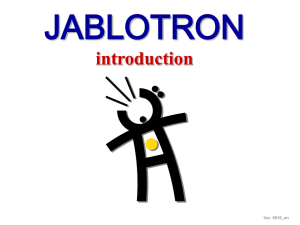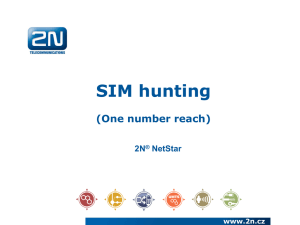Analysis of Mobile Infrastructure for Secure Mobile Payments
advertisement
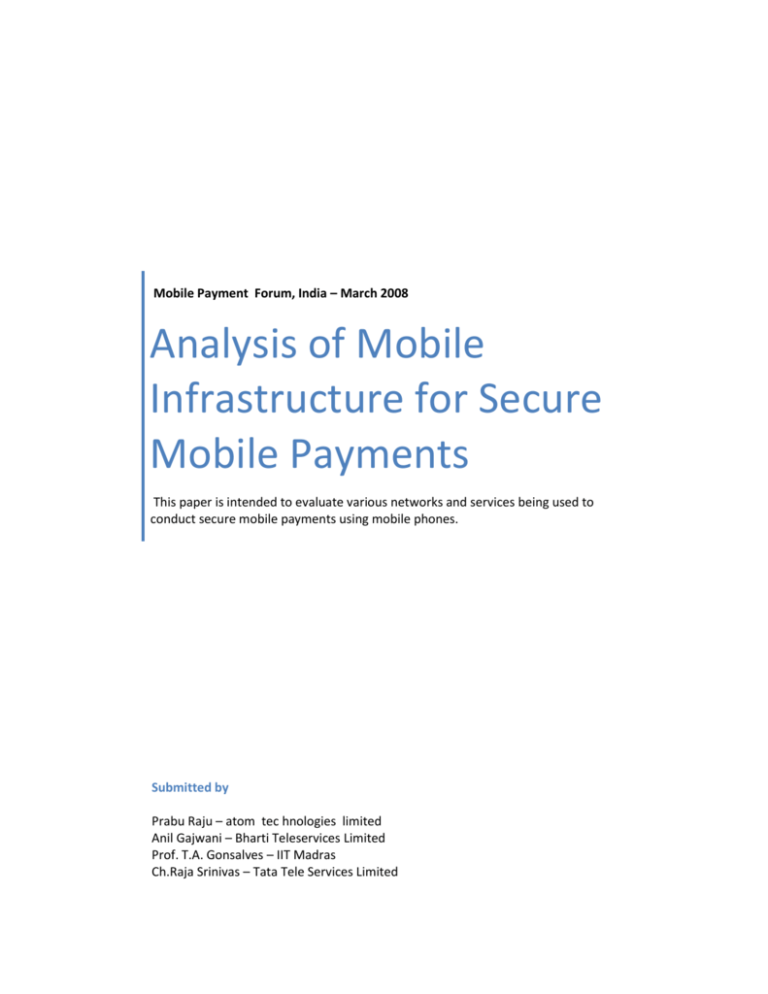
Mobile Payment Forum, India – March 2008 Analysis of Mobile Infrastructure for Secure Mobile Payments This paper is intended to evaluate various networks and services being used to conduct secure mobile payments using mobile phones. Submitted by Prabu Raju – atom tec hnologies limited Anil Gajwani – Bharti Teleservices Limited Prof. T.A. Gonsalves – IIT Madras Ch.Raja Srinivas – Tata Tele Services Limited Table of Contents Overview ...........................................................................................................................................3 Short Message Service (SMS)..............................................................................................................4 Unstructured Supplementary Services Data (USSD) .............................................................................6 General Packet Radio Service (GPRS) ..................................................................................................8 Code Division Multiple Access (CDMA) ...............................................................................................9 Appendix ......................................................................................................................................... 10 GSM Network .......................................................................................................................................... 10 References....................................................................................................................................... 13 Overview Mobile Payments is a new convenient scheme for customers to perform transactions, and is predicted to increase as the number of mobile phone users increases. The use of mobile devices, such as a cellular phones and PDAs, to make payments is increasingly common, particularly in Asia and Europe. Mobile payment can be defined as any payment transaction which involves a mobile device. There are wide ranges of options available to perform mobile payments due to the availability of network technologies. Mobile network technologies have evolved from analog based systems to digital based systems and from circuit switching to packet switching technologies. This evolution can be described by different generations of mobile technologies, i.e. first-generation (1G), second-generation (2G), 2.5G and thirdgeneration (3G) technologies. Only 1G is based on analog technology. Some of the main standards for each generation technology are: 1G: Advance Mobile Phone System (AMPS) in North America, Total Access Communication System (TACS) in UK, Nippon Telegraph & Telephone (NTT)in Japan, Code Division Multiple Access One (CDMAONE). 2G: Global System for Mobile Communication (GSM), Code Division Multiple Access 2000 (CDMA2000), High Speed Circuit Switched Data Technology (HSCSD). 2.5G: General Packet Radio System (GPRS) & Enhanced Data Rate for GSM Evolution (EDGE). 3G: Universal Mobile Telephone Standard (UMTS). Short Message Service (SMS) SMS provides a mechanism for transmitting short messages to and from wireless handset. Short Messaging Service was created as a part of the GSM Phase 1 standard to send and receive short text messages, of 70-160 alphanumeric characters in length, 8 bit Binary Message of 140 characters in length to and from mobile phones. SMS is a smart service, as it can store messages when to the target mobile device is switched off and forwards the messages when the unit is again in use. SMS applications are voicemail/fax notifications, delivery of replacement ring-tones, operator logos and group graphics, unified messaging, personal communication (text messaging), and information services. Basically, any information that fits into a short text message can be delivered by SMS. Security The initial idea for SMS usage was intended for the subscribers to send non-sensitive messages across the open GSM network. Mutual authentication, text encryption, end-to-end security, non-repudiation were omitted during the design of GSM architecture. SMS Spoofing SMS spoofing is an attack that involves a third party sending out SMS messages that appear to be from a legit sender. It is possible to alter the originator s address field in the SMS header to another alphanumerical string. It hides the original sender s address and the sender can send out hoax messages and performs masquerading attacks. SMS Encryption The default data format for SMS messages is in plaintext. The only encryption involved during transmission is the encryption between the base transceiver station and the mobile station. End-to-end encryption is currently not available. The encryption algorithm used is A5 which is proven to be vulnerable. Therefore a more secure algorithm is needed. The SMS security mechanism relies on GSM/UMTS signaling plane security mechanism. SMS may be eavesdropped by the man-in-the-middle attack as no encryption is applied to SMS message transmission. Conclusion SMS based mobile payment systems are already in use globally. There might be certain risks when using SMS in the payment transaction. The SMS can be used for mobile payments provided the customized client built by SIM toolkit or Java application is used for the deployment of SMS transaction to provide end-to-end encryption. Unstructured Supplementary Services Data (USSD) USSD is a mechanism of transmitting information via a GSM Network. USSD offers a real-time connection during a session. Turnaround response times for interactive applications are shorter for USSD than SMS because of the session-based feature of USSD. A USSD message can be upto 182 alphanumeric characters in length. Unstructured Supplementary Service Data allows interactive services between a MS and applications hosted by the Mobile Operator. These messages are composed of digits and the #, * keys, and allow users to easily and quickly get information/access services from the Operator. The first USSD services were called "Phase 1", or "MAP 1" and were only able to pass information from the handset to the USSD application with a confirmation. There was therefore no session held between the handset and the application. "Phase 2" (or "MAP 2") USSD added the capability for establishing a session instead of a once-off transaction. This meant that the handset and the USSD application could now have the technical equivalent of a dialogue. GSM handsets supported USSD from the first days of GSM, so unlike SMS, every single GSM handset in the world supports USSD. Phase 2 has been supported for years and over 99% of handsets currently in use can use sessions on the USSD bearer. USSD is a session oriented service, and can support a sequence of exchange of information. Phase 2 USSD also allows messages to be pushed onto a MS. It is several times faster than MO SMS messages since there is no store and forward of messages. The USSD gateway supports an open HTTP interface. Generally the USSD functionality is implemented in the following modes: Pull Mode, will handle Mobile Initiated USSD Requests. Push Mode will handle network Initiated USSD Requests. Most handsets also support NI USSD (network initiated USSD), also called "USSD Push". With NI USSD, the network can push information to the subscriber's handset. Another important fact about USSD, is that messages from handsets always route to the home network. This means that if you are roaming in another network, then dialing a USSD string on your phone will always route to the application on your home network. If you are used to accessing a particular service in your home network, then you will also be able to access it from another country. Conversely, roaming subscribers from other networks cannot access USSD services on a host network. Security USSD possesses no separate security properties; instead it relies on GSM/UMTS signaling plane security mechanism. Conclusion USSD solutions are already in use for mobile payments across the globe. Some measure of encryption or message integrity verification is required to provide a secure USSD based payment system. USSD cannot provide additional security on its own. Another application is used for the deployment of USSD transaction to provide end-to-end encryption General Packet Radio Service (GPRS) GPRS is a high-speed packet data technology, being deployed in GSM networks worldwide. This will greatly enhance the services available to the end-user of mobile data computing. GPRS allows for the sending and receiving of data at much higher speed than available today. Data transmissions speeds go from 9.6 kbps to a theoretical maximum speed of up to 171.2 kbps are achievable with GPRS using all eight timeslots at the same time. GPRS only uses its radio resources when users are actually sending or receiving data, therefore the available radio resource can be concurrently shared between several mobile data users, rather than dedicating a radio channel to a single user for a fixed period of time. This efficient use of scarce radio resources means that large numbers of GPRS users can potentially share the same bandwidth and be served from a single cell. Security The GPRS Core network is an integrated part of the GSM network; it is layered over the underlying GSM network, with added nodes to cater for packet switching. GPRS also uses some of the existing GSM network elements; some of these include existing Base Station Subsystems (BSS), Mobile Switching Centers (MSC), Authentication Centers (AUC), and Home Location Registers (HLR). Some of the added GPRS network elements to the existing GSM network include; GPRS Support Nodes (GSN), GPRS tunneling protocol (GTP), Access points, and the (Packet Data Protocol) PDP Context. GPRS security functionality is equivalent to the existing GSM security. From a security point of view the same advantages and short comings of GSM applies to GPRS service. At session initiation, a user is authenticated using secret information contained on a smart card called a Subscriber Identity Module (SIM). Authentication data is exchanged and validated with records stored in the HLR network node. The microwave links to the BSSs are extensively used when the operator opens its service. The voice and cipher keys Kc can be intercepted on these links. In order to avoid the attack, the operators should replace the weak A3/A8 algorithm with a strong one. Conclusion GPRS solutions are already in use for mobile payments across the globe. Application level security should be used to provide end to end transaction security. Even though most of the mobile phones support GPRS, not all the phone user activates the GPRS connection and in most of the countries GPRS is very expensive. Code Division Multiple Access (CDMA) Code Division Multiple Access (CDMA) is a proprietary standard for mobile communication, where GSM is an open standard. CDMA was pioneered by Qualcomm and enhanced by Ericsson. Both standards are in competition for dominance in the cellular world. CDMA is a spread spectrum technology, which means that it spreads the information contained in a particular signal of interest over a much greater bandwidth than the original signal. A CDMA call starts with a standard rate of 9.6 kbps, which is then spread to a transmitted rate of about 1.23 Mbps. Security By design, CDMA 2000 1xRTT technology makes eavesdropping very difficult, whether intentional or accidental. Unique to CDMA 2000 1xRTT systems, is the 42-bit PN (Pseudo-Random Noise) Sequence called “Long Code” to scramble voice and data. On the forward link (network to mobile), data is scrambled at a rate of 19.2 Kilo symbols per second (Ksps) and on the reverse link, data is scrambled at a rate of 1.2288 Mega chips per second (Mcps). CDMA 2000 1xRTT network security protocols rely on a 64-bit authentication key (A-Key) and the Electronic Serial Number (ESN) of the mobile. A random binary number called RANDSSD, which is generated in the HLR/AC, also plays a role in the authentication procedures. The A-Key is programmed into the mobile and is stored in the Authentication Center (AC) of the network. In addition to authentication, the A-Key is used to generate the sub-keys for voice privacy and message encryption. CDMA 2000 1xRTT uses the standardized CAVE (Cellular Authentication and Voice Encryption) algorithm to generate a 128-bit sub-key called the “Shared Secret Data” (SSD). The A-Key, the ESN and the network-supplied RANDSSD are the inputs to the CAVE that generates SSD. The SSD has two parts: SSD_A (64 bit), for creating authentication signatures and SSD_B (64 bit), for generating keys to scramble voice and encrypt signaling/data messages. The SSD can be shared with roaming service providers to allow local authentication. A fresh SSD can be generated when a mobile returns to the home network or roams to a different system. Third Generation technologies (3G) add more security protocols, including the use of 128-bit privacy and authentication keys. For CDMA2000 networks, new algorithms such as Secure Hashing Algorithm-1 (SHA-1) are being used for hashing and integrity, and the Advanced Encryption Standard, AES (Rijndael) algorithm for message encryption. The AKA (Authentication and Key Agreement) protocol will be used for all releases following CDMA2000 Release C. The AKA protocol will also be used in WCDMA-MAP networks, along with the Kasumi algorithm for encryption and message integrity. Conclusion CDMA solutions are already in use for mobile payments. CDMA is superior to 2G technology to GSM. CDMA is not widely used compared to GSM globally. Appendix GSM Network Global System for Mobile Communications (GSM) is the most popular standard for mobile phones in the world. Figure 1 shows the basic structure of the GSM architecture. Figure 1 – Basic Structure of GSM Architecture Security Mechanisms in GSM Network The GSM network has some security mechanism to prevent activities like Subscriber Interface Module (SIM) cloning, and stop illegally used handsets. GSM has methods to authenticate and encrypt data exchanged on the network. GSM Authentication Center The GSM authentication center is used to authenticate each SIM card that attempts to connect to the GSM network. The SIM card authentication takes place when a mobile station initially attempts to connect to the network, i.e. when a terminal is switched on. If authentication fails then no services are offered by the network operator, otherwise the (Serving GPRS Support Node) SGSN and HLR is allowed to manage the services associated with the SIM card. Authentication Procedure The authentication of the SIM depends on a shared secret key between SIM card and the AUC called Ki. This secret key is embedded into the SIM card during manufacture, and it is also securely replicated into the AUC. When the AUC authenticates a SIM, it generates a random number known as the RAND. It sends this RAND number to the subscriber. Both the AUC and SIM feed the Ki and RAND values into the A3/A8 (or operator proprietary algorithm (COMP128)) and a number known as Signed RESponse (SRES) is generated by both parties. If the SIM SRES matches the AUC SRES the SIM is successfully authenticated. Both the AUC and SIM can calculate a second secret key called Kc by feeding the Ki and the RAND value into the A5 algorithm. This would be used to encrypt and decrypt the session communications. After the SIM authentication the SGSN or HLR requests the mobile identity, this is done to make sure that the mobile station being used by the user is not black listed. The mobile returns the IMEI (International Mobile Equipment Identity) number; this number is forwarded to the EIR (Equipment Identity Register). The EIR authorizes the subscriber and responds back to the SIM with the status, if the mobile is authorized the SGSN informs the HLR and PDP Context activation begins. Problems with the A3/A8 authentication algorithm A3/A8 is the term used to describe the mechanism used to authenticate a handset on a mobile phone network. A3 and A8 are not actually encryption algorithms, but placeholders. In A3/A8 the commonly used algorithm is COMP128. COMP128 was broken by Wagner and Goldberg in less than a day. This raises concerns of having GPRS as a secure communication mechanism. After cracking COMP128 Wagner and Goldberg went on to prove that it was possible to obtain the Ki value, therefore making it possible to perform SIM cloning. In 1998, Berkeley Group published their analysis of COMP128 (carrier algorithm to implement A3). It summarized that it would take approximately 219 queries to the mobile unit to determine the secret key. This translates to just eight hours of airtime! There has been a release of COMP128-2 and COMP128-3 to cater for some of the SIM cloning issues, but the majority of the SIMs still being used use COMP128. Problems with A5 algorithm The A5 algorithm is used to prevent casual eavesdropping by encrypting communications between mobile station (handset) and BSS. Kc is the Ki and RAND value fed into the A5 algorithm. This Kc value is the secret key used with the A5 algorithm for encryption between the mobile station and BSS. There are at least three flavours of the A5 algorithm. These include A5/1 which is commonly used in western countries. The A5/1 is deemed strong encryption but it was reverse engineered some time ago. A5/2 has been cracked by Wagner and Goldberg, the methodology they used required five clock cycles making A5/2 almost useless. One uncovered flaw was ten zeroes introduced into the key, effectively creating a 54 bit key. The most devastating blow, in 1999, Adi Shamir and Alex Biryukov showed that the A5/1 algorithm could get broken on a PC in less than one second. Finally A5/0 is a form of A5 that does not encrypt data at all. All these problems with the A5 encryption algorithms prove that eavesdropping between mobile station and BSS is still possible, making GPRS over the GSM core network very insecure. Attack on the RAND value When the AUC attempts to authenticate a SIM card, the RAND value sent to the SIM card can be modified by an intruder failing the authentication. This may cause a denial of service attack. References - State of the Art Review of Mobile Payment Technology - David McKitterick and Jim Dowling The Future Mobile Payments Infrastructure - Institute for Communications Research Systems @ Work Pte. Ltd Security of Mobile Banking - Kelvin Chikomo, Ming Ki Chong, Alapan Arnab, Andrew Hutchison GSM and GPRS Security - Chengyuan Peng http://www.truteq.com/tips/ussd/ The Future Mobile Payments Infrastructure A Common Platform for Secure M-Payments CDMA 2000 1xRTT Security Overview Analysis of mobile payment security measures and different standards by Saleem Kadhiwal and Muhammad Anwar Usman Shaheed Zulfiquar CGAP MOBILE BANKING TECHNOLOGY MATRIX
